Introduction
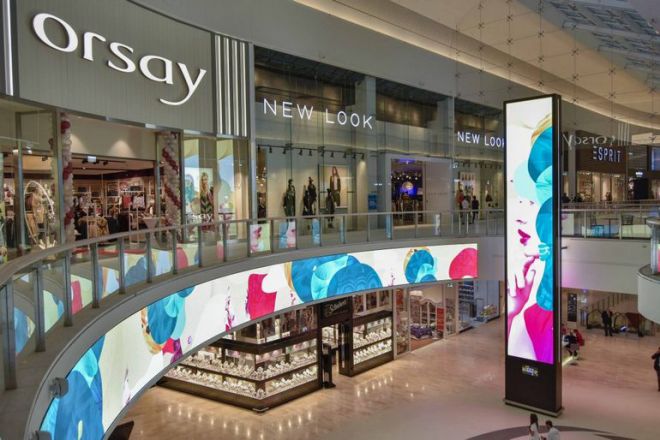
With the continuous development of science and technology and the increasing prosperity of the consumer market, shopping malls, as important carriers of the retail industry, are constantly innovating and upgrading their internal facilities and display methods.
As an indispensable part of modern shopping malls, LED display screens have become an important tool for shopping malls to attract customers and convey information due to their high brightness, high definition, energy saving, and environmental protection.
1. Suspended LED display
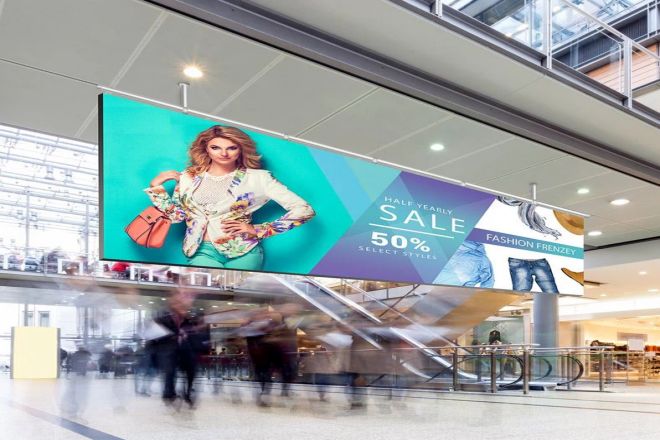
The suspended LED display is a special display technology that is installed on the ceiling of shopping malls, exhibition halls, or other public places by hanging or suspending. It uses LEDs (light-emitting diodes) as pixel units, which can display high-definition, dynamic videos, pictures, and text information, and can be used in various scenarios such as brand advertising, promotional activities, and information release.
1). Features:
High-altitude display: suspended from the ceiling, providing the audience with a top-to-bottom visual experience.
High definition: LED pixels are densely packed and can display high-definition and detailed images and videos.
Bright colors: LED has high color reproduction and can present bright and realistic color effects.
Dynamic display: Supports a variety of dynamic effects and transition effects to make the content more vivid.
2). Application scenarios:
Shopping mall entrance: As the “face” of the mall, it attracts customers to enter and displays the latest promotional information.
Shopping mall atrium: Located in the central area of the shopping mall, it is a good place for customers to stay and rest and is suitable for displaying brand advertisements or event information.
Corridors and passages: guide customers forward while displaying relevant merchandise or brand information.
Exhibition Hall: Display exhibit information, brand introduction, etc., during exhibition activities.
3). Advantage:
Good visual effects: The visual experience from top to bottom is more impactful and easily attracts customers’ attention.
High flexibility: The installation is flexible and can be adjusted according to the actual conditions and needs of the site.
Fast information update: Content is updated quickly, making it easy for merchants to adjust their promotion strategies at any time.
Energy saving and environmental protection: LED display screen has low power consumption, long service life, and meets environmental protection requirements.
4). Shortcoming:
High maintenance costs: Since it is installed on the ceiling, maintenance requires professionals, which increases maintenance costs.
Regular inspections are required: Suspended LED displays require regular inspections of cables, connectors, and other components to ensure their stability and safety.
Affected by environmental factors: Environmental factors such as temperature and humidity may affect the performance and life of the display.
Strict installation requirements: factors such as load-bearing and stability must be considered during installation to ensure the safe operation of the display.
2. Floor-standing LED display
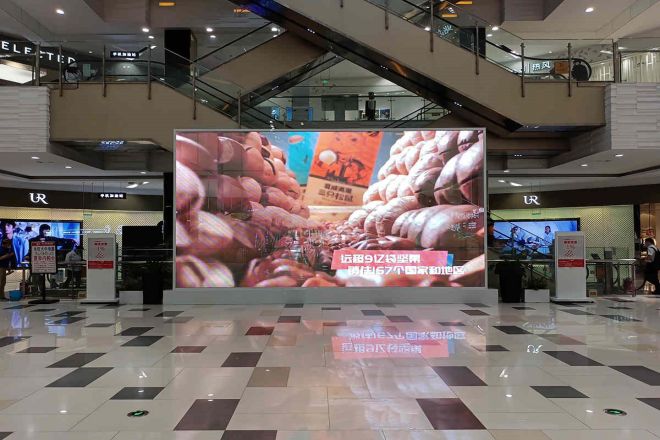
The floor-standing LED display is a vertical design that can be placed directly on the floor of a shopping mall or next to a counter. It uses LEDs (light-emitting diodes) as pixel units, which can display high-definition, dynamic videos, pictures, and text information, providing viewers with a close viewing experience.
1). Features:
Vertical structure: The vertical design makes the display stable and easy to place in various places.
High-definition display: The LED display has a high pixel density and can present clear and detailed images and videos.
Strong interactivity: supports a variety of interactive functions, such as touch screen, gesture recognition, etc., to enhance the audience’s sense of participation.
2). Application scenarios:
Brand counter: Place a floor-standing LED display next to the brand counter to display brand stories, product features, promotional activities, and other information to attract customers’ attention.
Product display area: used to display the characteristics, uses, and usage methods of new products or hot-selling products, etc., to assist sales staff in introducing products to customers.
Rest area: Place a floor-standing LED display in the rest area to play advertisements, news, or entertainment programs to provide customers with a comfortable rest environment.
3). Advantage:
Rich display content: Various forms of advertisements and information can be played to meet the needs of different occasions.
Strong interactivity: Through touch screen, gesture recognition, and other technologies, it can interact with the audience and enhance the audience’s sense of participation and experience.
Adjustable position: The position and height of the display can be adjusted as needed to accommodate different viewing angles and distances.
4). Shortcoming:
Occupying floor space: Since it needs to be placed on the ground or next to the counter, it will occupy a certain amount of space, which may affect customers’ passage and shopping experience.
Maintenance costs: Although relatively low, regular cleaning and inspection are still required to ensure the normal operation and extended service life of the display.
Safety hazards: In crowded places, it is necessary to ensure the stability of the display to avoid safety accidents such as tipping or collisions.
3. Showcase-type LED display
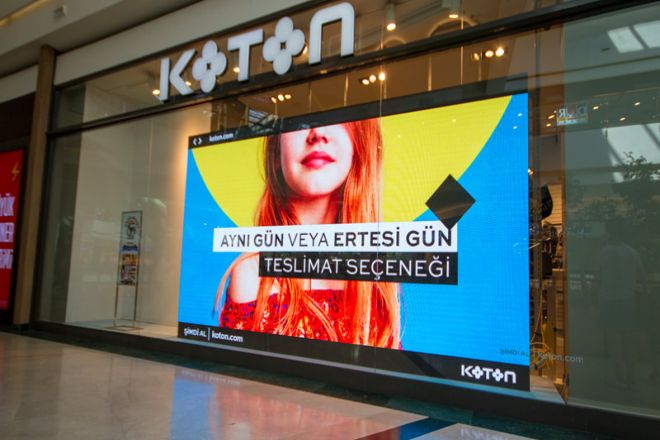
The window-type LED display screen is a display screen installed inside the shopping mall window and closely integrated with the product display. It uses LED technology to display high-definition, dynamic images, and videos, providing a more attractive display method for products.
1). Features:
Integration with product display: The window-type LED display is closely integrated with the product display and can directly display information such as the characteristics, uses, and promotional activities of the product to enhance its attractiveness.
High-definition display: The LED display has a high pixel density and can present clear and detailed images and videos, making product display more vivid and lifelike.
Flexible content replacement: The content of the window-type LED display can be flexibly replaced according to factors such as seasons, festivals, or promotions, keeping the display fresh and attractive.
2). Application scenarios:
Brand stores: In brand stores, window-type LED displays can be used to display brand stories, new product releases, promotional activities, and other information to enhance brand image and appeal.
High-end product display area: In the high-end product display area, the window-type LED display can display information such as product details, materials, and production processes, increasing the added value and attractiveness of the product.
3). Advantage:
Intuitive display effect: The window-type LED display can intuitively display the features and advantages of the product, making it easier for customers to be attracted and interested.
Improve product attractiveness: Through high-definition, dynamic images and video displays, window-type LED displays can significantly enhance the attractiveness of products and increase customers’ desire to purchase.
Strong flexibility: The content of the window-type LED display can be flexibly changed as needed to adapt to different seasons, festivals, or promotional activities, keeping the display fresh and attractive.
4). Shortcoming:
High cost: The production and installation costs of window-type LED displays are relatively high, requiring businesses to invest a certain amount of money.
The display content needs to be changed regularly: In order to keep the display fresh and attractive, merchants need to regularly change the display content of the window-type LED display, which requires the investment of certain human and material resources.
4. How do you know which of the three installation methods to choose for your LED display?
When choosing an LED display installation method, the three factors of budget, visual effects, and maintenance and management need to be carefully considered to ensure that the final choice can meet your actual needs.
- Budget:
Budget is the primary factor in choosing an LED display installation method. Different installation methods will involve different costs, including the purchase of installation equipment, labor costs during the installation process, and subsequent maintenance costs.
You need to know your budget range and choose the most economical and reasonable installation method accordingly. Suspended installation usually requires more brackets and load-bearing equipment, and the cost may be relatively high; floor-standing installation is relatively simple and low-cost; window-type installation needs to consider the structure and customization of the window, and the cost may also rise.
- Visual effect:
The visual effect is another important factor in the choice of installation method for LED displays. Different installation methods will have different visual effects on the display. Suspension installation can place the display screen in the air to form a suspended visual effect, attracting the attention of passers-by.
Floor-standing installation can place the display screen on the ground or next to the counter to facilitate customers to watch at close range; window-type installation can Combine the display screen with the product display in the window to create a unique visual effect. You need to choose the visual effects that best suit your products based on your display needs.
- Maintenance and management:
Maintenance and management are long-term factors that need to be considered when choosing an LED display installation method. Different installation methods will also have differences in maintenance and management. Suspended installation is more difficult because the display screen is in the air, and maintenance may require professional equipment and personnel.
Floor-standing installation can directly contact the display screen for operation, and maintenance is relatively easy; window-type installation requires considering the structure and size of the window, and maintenance may need to be combined with the design of the display window.
You need to choose an installation method that is easy to maintain and manage based on your actual situation to reduce maintenance costs and time in long-term use.
4. The development trend of LED display screens in shopping malls
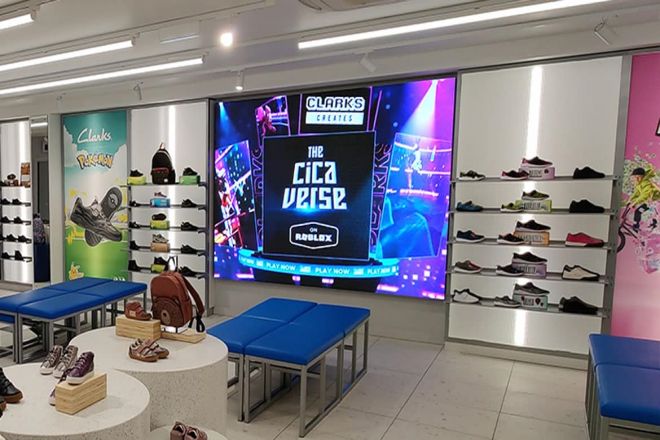
The development trend of LED display screens in shopping malls is indeed as you mentioned. The following is a more detailed explanation:
- Technological innovation
With the continuous advancement of technology, the resolution, brightness, contrast, and other performance of LED displays will continue to improve. A high-resolution display can provide clearer and more detailed images and videos, giving viewers a better visual experience.
The high-brightness and high-contrast display screen can maintain the clarity and color vividness of the picture under various light conditions, ensuring the effective communication of information.
- Personalized customization
In shopping malls, merchants are paying more and more attention to the shaping of brand image and the improvement of customer experience. Therefore, the demand for personalized customization of LED displays will gradually increase.
Merchants can customize personalized displays in size, shape, color, function, etc., based on their own brand image, display needs, site conditions, and other factors to better display products, convey information, and create an atmosphere.
- Green
LED display screens have the advantages of energy saving and environmental protection and are in line with the green development trend of modern society. Compared with traditional displays, LED displays consume less power and can significantly reduce energy consumption and operating costs.
At the same time, the life of the LED display is also longer, reducing the generation of electronic waste and having less impact on the environment. Therefore, the use of LED displays in shopping malls can not only enhance brand image and customer experience but also bring dual environmental and economic benefits to merchants.
- Intelligent management
With the continuous development of technologies such as the Internet of Things and big data, intelligent management and remote monitoring of LED displays will become possible. Merchants can perform remote control, content update, fault diagnosis, and other operations on the display screen through the intelligent management platform to achieve intelligent management and efficient operation of the display screen.
At the same time, the intelligent management platform can also provide merchants with accurate marketing strategies and data analysis support based on shopping mall passenger flow, sales data, and other information, helping merchants better grasp market opportunities and improve operating efficiency.
Conclusion
To sum up, LED displays in shopping malls, with their diverse types and wide range of application scenarios, provide merchants with rich display methods and also bring consumers a more colorful shopping experience.
With the continuous advancement of technology and the changing market, LED displays will continue to play an important role in shopping malls and continue to introduce new ones to inject new vitality into the development of shopping malls.
Finally, if you want to know more about LED displays, please get in touch with us.
